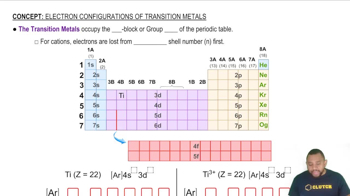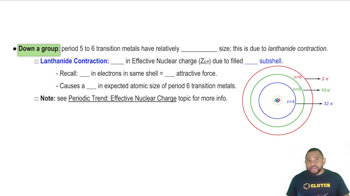Here are the essential concepts you must grasp in order to answer the question correctly.
Periodic Trends
Periodic trends refer to the predictable patterns observed in the properties of elements across the periodic table. Atomic radius generally decreases across a period due to increased nuclear charge, which pulls electrons closer to the nucleus. However, trends can vary in transition metals, where d-orbitals influence electron shielding and atomic size.
Recommended video:
Transition Metals
Transition metals are elements found in the d-block of the periodic table, characterized by their ability to form variable oxidation states and complex ions. The atomic radii of transition metals can be similar due to the filling of d-orbitals, which leads to comparable electron shielding effects and effective nuclear charge, as seen in zirconium and hafnium.
Recommended video:
Lanthanide Contraction
Lanthanide contraction refers to the phenomenon where the atomic and ionic radii of the lanthanide series decrease with increasing atomic number. This occurs due to poor shielding of the nuclear charge by the f-electrons, resulting in a stronger attraction between the nucleus and the outer electrons. This effect extends to the subsequent transition metals, contributing to the similar atomic sizes of zirconium and hafnium.
Recommended video:
 Verified step by step guidance
Verified step by step guidance


